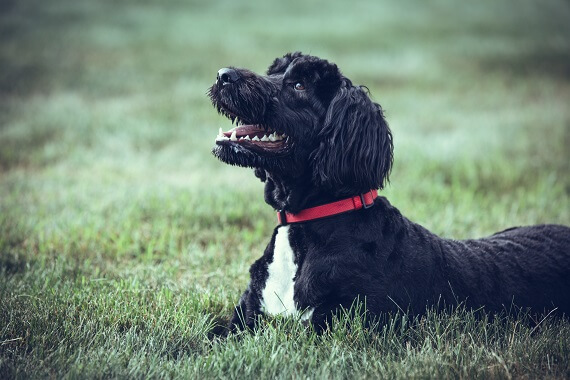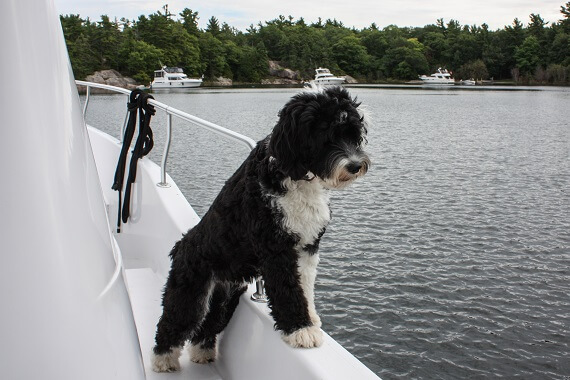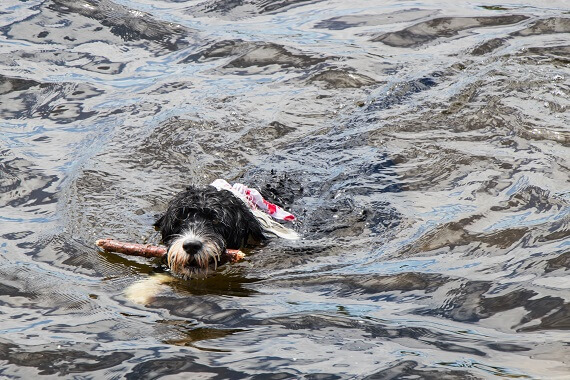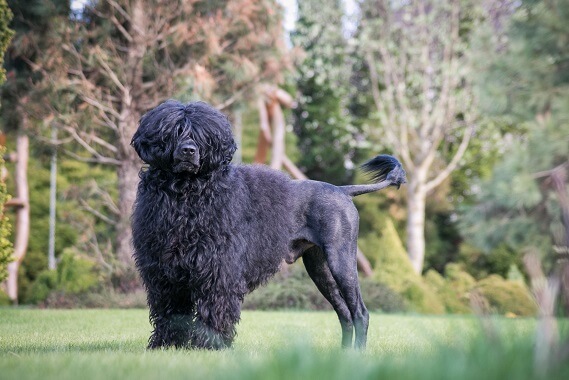
The Portuguese Water Dog – known as cau de agua in Portuguese which means “dog of water” – is a medium-sized dog that is bright and eager to please. This robust dog was developed in Portugal, where it was bred to help fishermen at sea. These dogs are an old breed, with the first written account of their existence dating back to 1297. Portuguese Water Dogs once worked as part of a fishing crew and assisted Portuguese fishermen out at sea by retrieving lost gear or herding fish into nets. They would do this by diving into the water and bringing back lost gear or herding the fish in the direction of the nets. These dogs could dive as deep as 12 feet while chasing fish! They have an athletic body and webbed feet, which act like flippers, propelling them through the water. They also have a strong tail that acts as a rudder and a waterproof coat. This makes them excellent swimmers and well built for water work. Their coat is medium-length and comes in two varieties; either the hair is found in tight curls or it is wavy and glossy. They have no undercoat and do not shed. These dogs are either black, brown, or white and can sometimes have white patches. These dogs are considered high maintenance as they require frequent bathing and grooming to prevent their coat from becoming matted. Portuguese Water Dogs are intelligent, independent, and highly active. They need a substantial amount of exercise and as their name suggests, they love water. These dogs need activities to keep them stimulated and prevent them from becoming bored. Otherwise, they will likely engage in destructive behavior such as digging and chewing. These smart dogs are easy to train and are good at a wide range of sports such as agility. The Portuguese Water Dog was born to swim and was a great companion to Portuguese fishermen. These skilled swimmers helped the Spanish Armada by carrying messages between ships and were also used by a baseball team to retrieve balls that were hit into the cold waters of San Francisco bay. However, despite their current popularity these dogs nearly once went extinct! Let’s take a closer look at the Portuguese Water Dog! Advancements in technology in the early 20th century meant that the fishing industry didn’t need to rely on these dogs quite so much. This caused the numbers to fall and the population of Portuguese Water Dogs was nearly wiped out. Luckily, in the 1930s Vasco Bensaid, a Portuguese businessman, took an interest in the breed and managed to save them. He found the dogs from the fishermen and enrolled them in a breeding program. Vasco Bensaid adopted his own Portuguese Water Dog, named Leao, who became the founding sire of the breeding program. Bensaid went on to found the Portuguese Water Dog Club. A few decades later, the breed started making appearances at dog shows and gained popularity as a family pet outside of Portugal. In more recent times, the breed has been made famous by several celebrities including Barack Obama, who has two Portuguese Water Dogs, Bo, and Sunny. Portuguese Water Dogs are one of the best swimmers amongst dog breeds, so much so that for a couple of seasons these dogs were used by the San Francisco Giants. These dogs were used to fetch home run balls that were hit from the Pacific Bell Park into the waters of San Francisco Bay. Starting in 2000, several Portuguese water dogs, known collectively as B.A.R.K. (Baseball Aquatic Retrieval Korps), were used to fetch baseballs that went astray. While most of the retrieving was done during practice hours, any balls that the dogs retrieved during the game were auctioned off for money by Pets In Need, a non-profit no-kill shelter. The Portuguese Water Dog ether has a curly or a wavy coat, but regardless of the coat type, there are two types of haircuts that the Portuguese Water Dog can have according to breed standards. The retriever clip is a classic, straight forward hair cut for this dog. The whole coat is trimmed to about an inch in length, including the legs and head. However, the feet and the top of the head are left with a little more hair. Like the body, the ears and muzzle are also kept short, as is the tail apart from on the tip where a tuft of hair is left. In contrast, the lion clip is a cut that makes the Portuguese Water Dog stand out from the crowd! In this unique cut, the back half of the dog is trimmed short except for a tuft on the end of the tail. The fur on the front part of their body is left a few inches longer, creating a very unique look for these dogs!
Kingdom
Animalia
Phylum
Chordata
Class
Mammalia
Order
Carnivora
Family
Canidae
Genus
Canis
Species
Canis lupus
Subspecies
Canis lupus familiaris
Height
17 – 23 inches (43.2 – 58.4 cm)
Weight
35 – 60 lbs (13.6 – 27.2 kg)
Lifespan
11 – 13 years
Social Structure
Domesticated, working dog
Status
Least concern
Natural Habitat
Domesticated
Average Litter Size
4 – 8 puppies
Main food item
Dog food
Potential predators
Few predators
The Basics

Fun Facts about the Portuguese Water Dog!
They Nearly Went Extinct

Baseball Aquatic Retrieval Korps

Retriever or Lion Clip?
